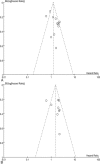Overexpression of glypican-3 is a predictor of poor prognosis in hepatocellular carcinoma: An updated meta-analysis
- PMID: 29901640
- PMCID: PMC6024095
- DOI: 10.1097/MD.0000000000011130
Overexpression of glypican-3 is a predictor of poor prognosis in hepatocellular carcinoma: An updated meta-analysis
Abstract
Background: Glypican-3 (GPC3) has been widely recognized in the progression of liver tumors for several years. The relationship between overexpression of GPC3 and the poorer prognosis of patients with hepatocellular carcinoma (HCC) was performed by 2 meta-analyses. However, there were also some latest literatures that indicated different conclusions distinctly. It is necessary for us to carry out a meta-analysis by adding the latest data from current studies to explore the correlation between GPC3 and prognostic value in HCC.
Methods: We conducted a meta-analysis including a total of 14 studies to assess the potential prognostic significance of GPC3 expression for overall survival (OS) and disease-free survival (DFS). The expression of GPC3 was assessed by immunohistochemistry.
Results: Fourteen studies with 2364 patients were incorporated in the meta-analysis. The combined hazard ratios (HRs) revealed that the overexpression of GPC3 could forecast a poor OS [n = 2233 in 12 studies, HR = 1.40, 95% confidence interval (95% CI): 1.07-1.85, Z = 2.42, P = .02] and DFS (n = 1308 in 10 studies, HR = 1.61, 95% CI: 1.13-2.30, Z = 2.63, P = .008) in HCC patients. Subgroup treated by hepatectomy indicated that the pooled HR of OS was 1.43 (95% CI: 1.01-2.01, P = .04) and the combined HR of DFS was 1.59 (95% CI: 1.09-2.31, P = .02). The pooled odds ratios (ORs) showed that high GPC3 expression was also extensively associated with worse tumor differentiation, later tumor stage, presence of vascular invasion, and hepatitis B virus (HBV) infection. Subgroup analyses for GPC3 on HCC OS based on the studies categorized by regions, follow-up period, and sample size were also conducted.
Conclusion: The meta-analysis indicated that overexpression of GPC3 was significantly associated with poor prognosis in patients with HCC.
Conflict of interest statement
The author reports no conflicts of interest in this work.
Figures







Similar articles
-
Prognostic and clinicopathological significance of glypican-3 overexpression in hepatocellular carcinoma: a meta-analysis.World J Gastroenterol. 2014 May 28;20(20):6336-44. doi: 10.3748/wjg.v20.i20.6336. World J Gastroenterol. 2014. PMID: 24876756 Free PMC article.
-
Prognostic significance of glypican-3 in hepatocellular carcinoma: a meta-analysis.BMC Cancer. 2014 Feb 18;14:104. doi: 10.1186/1471-2407-14-104. BMC Cancer. 2014. PMID: 24548704 Free PMC article.
-
Recurrence and poor prognosis following resection of small hepatitis B-related hepatocellular carcinoma lesions are associated with aberrant tumor expression profiles of glypican 3 and osteopontin.Ann Surg Oncol. 2012 Jul;19 Suppl 3:S455-63. doi: 10.1245/s10434-011-1946-2. Epub 2011 Aug 6. Ann Surg Oncol. 2012. PMID: 21822558
-
Prognostic significance of glypican-3 expression in hepatocellular carcinoma: A meta-analysis.Medicine (Baltimore). 2018 Jan;97(4):e9702. doi: 10.1097/MD.0000000000009702. Medicine (Baltimore). 2018. PMID: 29369198 Free PMC article. Review.
-
Glypican-3 is a prognostic factor and an immunotherapeutic target in hepatocellular carcinoma.World J Gastroenterol. 2016 Jan 7;22(1):275-83. doi: 10.3748/wjg.v22.i1.275. World J Gastroenterol. 2016. PMID: 26755876 Free PMC article. Review.
Cited by
-
GPC3 gene expression and allelic discrimination of FZD7 gene in Egyptian patients with hepatocellular carcinoma.Rep Pract Oncol Radiother. 2023 Aug 28;28(4):485-495. doi: 10.5603/RPOR.a2023.0049. eCollection 2023. Rep Pract Oncol Radiother. 2023. PMID: 37795234 Free PMC article.
-
Evaluation of glypican‑3 in patients with hepatocellular carcinoma.Mol Clin Oncol. 2024 Oct 23;22(1):1. doi: 10.3892/mco.2024.2796. eCollection 2025 Jan. Mol Clin Oncol. 2024. PMID: 39534882 Free PMC article.
-
Increased serum glypican-3 is associated with liver stiffness and hepatic dysfunction in children with biliary atresia.Clin Exp Hepatol. 2019 Mar;5(1):48-54. doi: 10.5114/ceh.2019.83156. Epub 2019 Feb 20. Clin Exp Hepatol. 2019. PMID: 30915406 Free PMC article.
-
A Humanized Anti-GPC3 Antibody for Immuno-Positron Emission Tomography Imaging of Orthotopic Mouse Model of Patient-Derived Hepatocellular Carcinoma Xenografts.Cancers (Basel). 2021 Aug 6;13(16):3977. doi: 10.3390/cancers13163977. Cancers (Basel). 2021. PMID: 34439132 Free PMC article.
-
Liver Cell Type-Specific Targeting by Nanoformulations for Therapeutic Applications.Int J Mol Sci. 2023 Jul 24;24(14):11869. doi: 10.3390/ijms241411869. Int J Mol Sci. 2023. PMID: 37511628 Free PMC article. Review.
References
-
- Mazzanti R, Gramantieri L, Bolondi L. Hepatocellular carcinoma: epidemiology and clinical aspects. Mol Aspects Med 2008;29:130–43. - PubMed
-
- Sherman M. Hepatocellular carcinoma: epidemiology, surveillance, and diagnosis. Semin Liver Dis 2010;30:3–16. - PubMed
-
- Tang Z-Y, Ye S-L, Liu Y-K, et al. A decade's studies on metastasis of hepatocellular carcinoma. J Cancer Res Clin Oncol 2004;130:187–96. - PubMed
-
- Avielronen S, Lau SK, Pintilie M, et al. Glypican-3 is overexpressed in lung squamous cell carcinoma, but not in adenocarcinoma. Mod Pathol 2008;21:817–25. - PubMed
-
- Chen M, Li G, Yan J, et al. Reevaluation of glypican-3 as a serological marker for hepatocellular carcinoma. Clin Chim Acta 2013;423:105–11. - PubMed
Publication types
MeSH terms
Substances
LinkOut - more resources
Full Text Sources
Other Literature Sources
Medical

